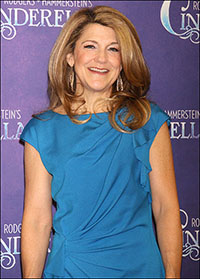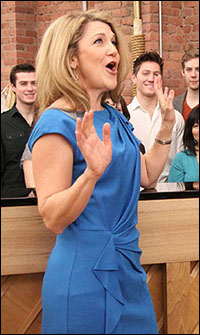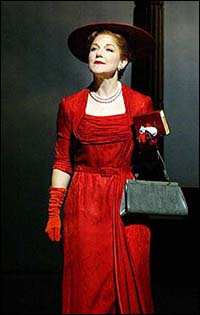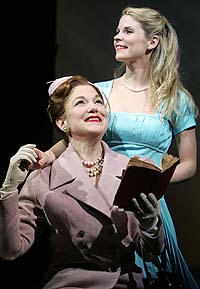
Victoria Clark, the Tony-winning singing actress who imbues her work with great humanity, palpable warmth and rich humor in unexpected places, is back on Broadway in the Main Stem debut of Rodgers & Hammerstein's Cinderella, which also boasts Laura Osnes, Santino Fontana and Tony winner Harriet Harris.
It was during her Tony-nominated run in Broadway's Sister Act, where Clark again impressed with a surprisingly touching journey as Mother Superior, that the gifted soprano first heard about the role of Marie in Cinderella, which features a new book by Douglas Carter Beane, who handled similar duties for Sister Act. "As far back as during [Sister Act] previews," Clark recently said with a laugh, "[Douglas] would skip into my dressing room and kind of plop down on my sofa and just say, 'I have your next part!' I was like, 'I can't [concentrate on a new role]. I'm in the convent. I've got stuff to think about.' And, he was like, 'No, no, no, really, seriously. I'm writing this — I have this part for you. Crazy Marie…It's great. It's great. She's the Fairy Godmother, but she's really a homeless person. She's a bag lady.' And, I was like, 'Oh my gosh, type casting! Perfect!' He kept dropping hints along the way, and the first reading was a year ago — over a year ago.
"That's a score that I grew up with, and a score that I love," Clark explained, "and I had never worked with [director] Mark Brokaw, and I really wanted to work with him and had admired his work forever and heard he was fantastic to work with. Laura Osnes I knew as a colleague, but never worked with her. And then when I met with Mark, he said, 'You're definitely flying!' The design team started working almost immediately after the first reading — we had a positive response from the reading — and [producer] Robyn Goodman just went into like super-duper overdrive, getting everything organized and pre-planned. She got the design team together. It was sort of presented to me in such a way that I was very excited about it… When you put all those great people together, and the flying, and the score, it's like, 'Okay, this is a no-brainer!'"
| |
 |
|
| Clark at a January press event for Cinderella. | ||
| photo by Joseph Marzullo/WENN |
"But, on a more spiritual level," Clark added, "I had a real experience during one of our last dress rehearsals with the orchestra, where I looked down, and I could see everybody doing their job offstage, and I realized that no one was looking up at me because people forget after a while that I'm hanging up there. I realized this must be what the angels feel like, or when people that we love look back and look after us, and I just had a real moment of thinking, 'This is the perspective that this character needs to understand that they're involved, but there's only so much that they can do.' They can see, and their perspective is different on what's happening with the humans. I really understood it in a different way, and it was very moving to me."
| |
 |
|
| Clark performs at a Cinderella press preview. | ||
| Photo by Joseph Marzullo/WENN |
And, how does librettist Beane's version of the Cinderella fairytale differ from its previous incarnations?
"Well," the actress explained, "I think in broad terms you could say that it's like when you find an old house that's gorgeous and charming, and you love the structure of it, and you don't want anything to change its historic value or significance, so you kind of landmark it, and you work from there — that's what this feels like. He's taken the bones of a show, which was a teleplay, and not really Broadway-show length, and added a few rooms and kept it very much in character of the original charm, with Rodgers and Hammerstein [Organization]'s blessing… He's kept the charm and the intent and the bones of a really iconic, old story that's thousands of years old. In every culture, there's a 'Cinderella' story — Chinese culture, Eastern Europe is full of them, and they're everywhere, and they've been around thousands of years — so he researched all of those, pulled from the best of all the different traditions, added some characters that were not in the original, and is saying what he wants to say about the story. So what you look at when you see it is the iconic fairytale, but then, when you open the door and you go inside, you see, 'Oh, this is modern at the same time, but very much in keeping with the old bones.'
| |
 |
|
| Clark in The Light in the Piazza. | ||
| photo by Joan Marcus |
About director Brokaw, the Drama Desk-winning director of How I Learned to Drive who was represented on Broadway last season with the critically acclaimed The Lyons, Clark said, "He's very kind. He's very patient. He doesn't get in an actor's business. He's very astute, so he watches our process, and he sees us working stuff out, but he doesn't get in the middle of it, so, for me personally, it's been a joy because I'm still figuring so many things out, and he sees me working on things, and then he'll guide and direct… He's looking at the process, and he's been very, very good shaping the material, and he has a very good overarching vision for the piece. And, I think, aesthetically, the way this moves — the way he's worked with Anna Louizos and William Ivey Long and Kenneth Posner, the designers — is seamless. I don't think there's a single blackout in the show. It's very cinematic."
| |
 |
|
| Clark and Kelli O'Hara in The Light in the Piazza. | ||
| Photo by Joan Marcus |
Clark, who won her Tony for her beautifully layered performance as Margaret in The Light in the Piazza, said that her 18-year-old son Thomas Luke is currently in rehearsal for his high school production of that Adam Guettel-Craig Lucas musical. "He had his first music rehearsal this week and his first Italian coaching, and he calls up and says, 'Mom, this is going to be sick!,' which is the 18-year-old way of saying 'really good.' He's very new to the whole theatre thing, but their drama director is something else. He's really, really special, so I think they're going to put together a great production.… [Thomas is] playing Signor Naccarelli. I got him ready for his audition and coached a couple of his friends. We'll probably work on the singing a little bit, but he's pretty independent. He's a smart actor. We'll see how much he actually needs from me.… It's very adult, and it's very hard, but these are unusually old souls at this school, and the young lady who's playing Margaret is very special, and I got to work with her, and I'll be able to work some more with her. … If any 17- and 18-year-olds can pull it off, it's this group.
"You know, come on, I played Mame when I was 18," Clark said with a laugh. "You're always playing parts that you shouldn't be playing, but it's good experience to wrap your brain around the material, and they're really lucky."
Clark also feels lucky about her own latest role in the Broadway premiere of Cinderella. "The major ingredient in this production is joy," she said. "You can feel it everywhere. We have the best ensemble I've ever worked with. Every single one of them is a triple threat, and they're just delightful human beings and funny, the funniest people I've ever met. From the very top to the very bottom, we've got a core of special people."
[Rodgers & Hammerstein's Cinderella plays the Broadway Theatre, 1681 Broadway at 53rd St. For tickets visit telecharge.com. Visit CinderellaOnBroadway.com.] Well, that's all for now. Happy diva-watching! E-mail questions or comments to [email protected].
Here's a look at Cinderella in rehearsal:










